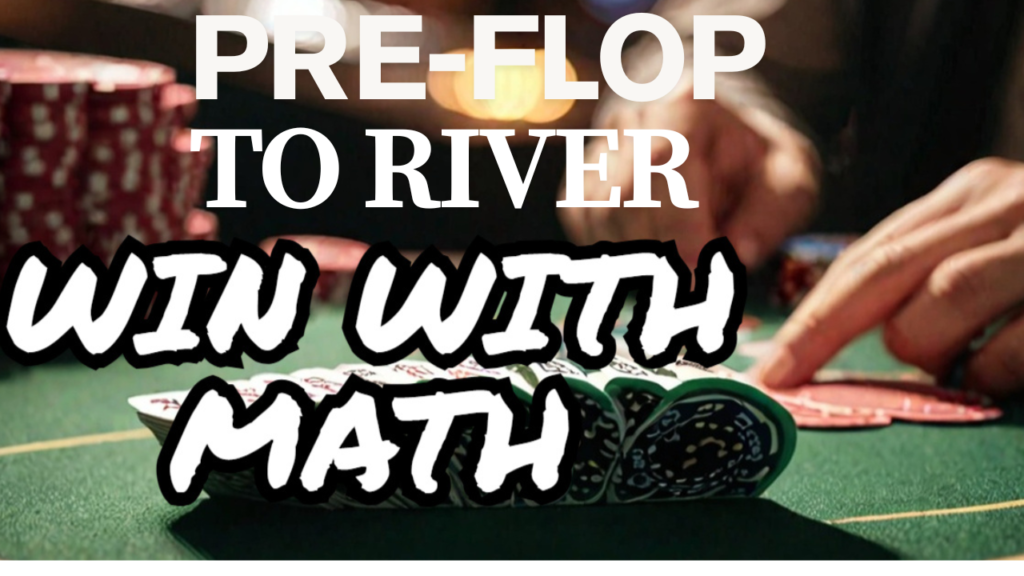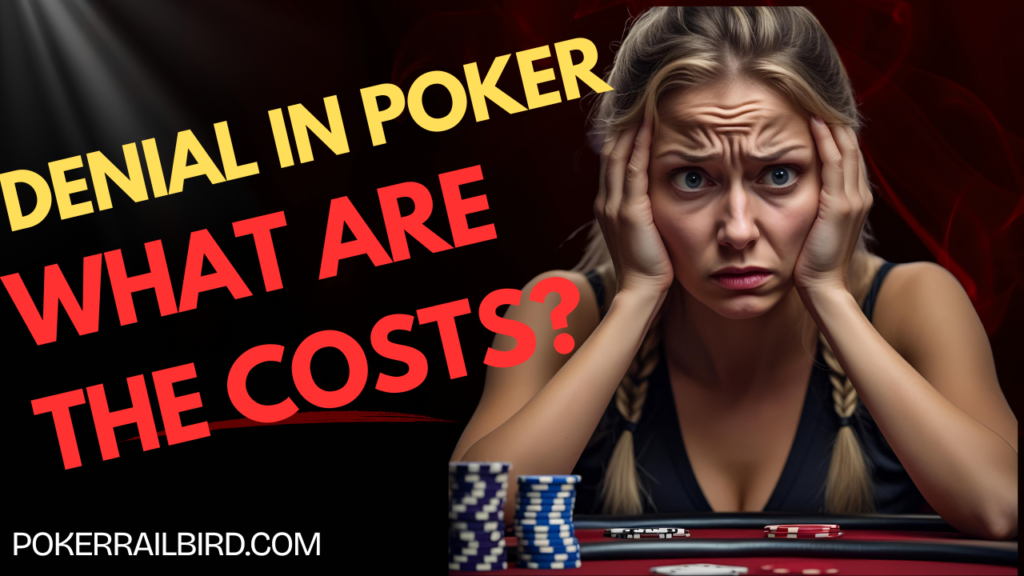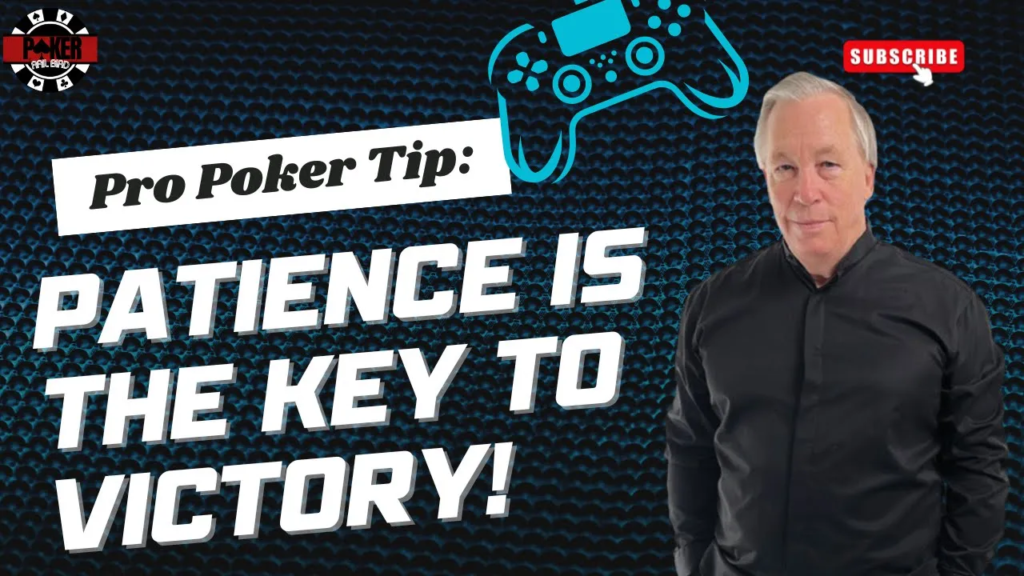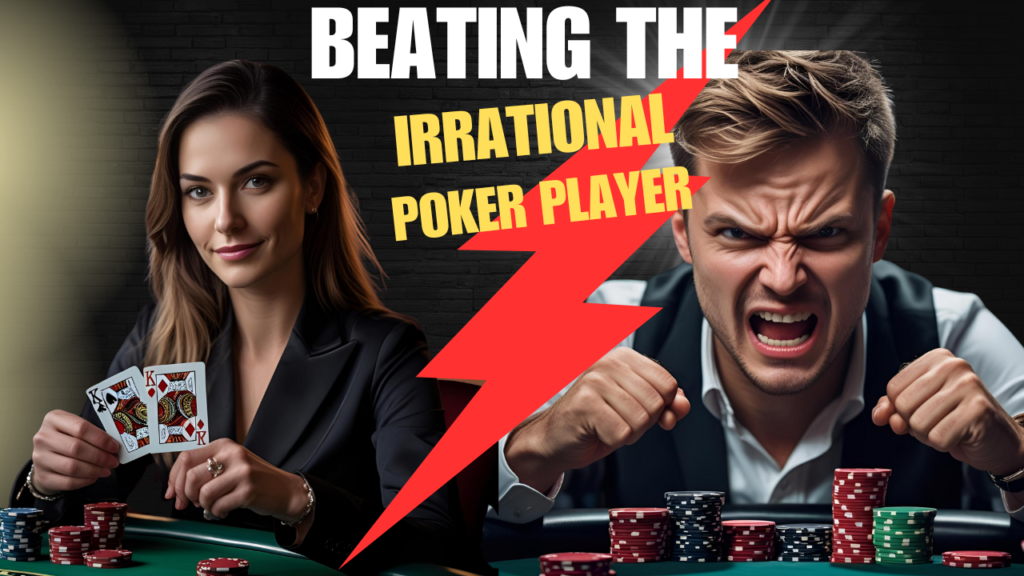HOW TO WIN IN POKER WHEN LOGIC BREAKS DOWN
BEATING THE UNBEATABLE
If you want to beat bad poker players, you have to rethink the game. Forget applying textbook poker the way you were taught — bad poker players don’t play by the math, the theory, the careful hand selection and pot odds calculations. In some of today’s wildest games, that stuff barely slows down the madness.
If you’ve ever tried to beat truly bad poker players, you already know what I’m talking about. The ones who play J/4 offsuit like it’s pocket Aces and who cold-call $25 preflop with 9/2 suited from under the gun. The ones who never fold — ever — and somehow still win.
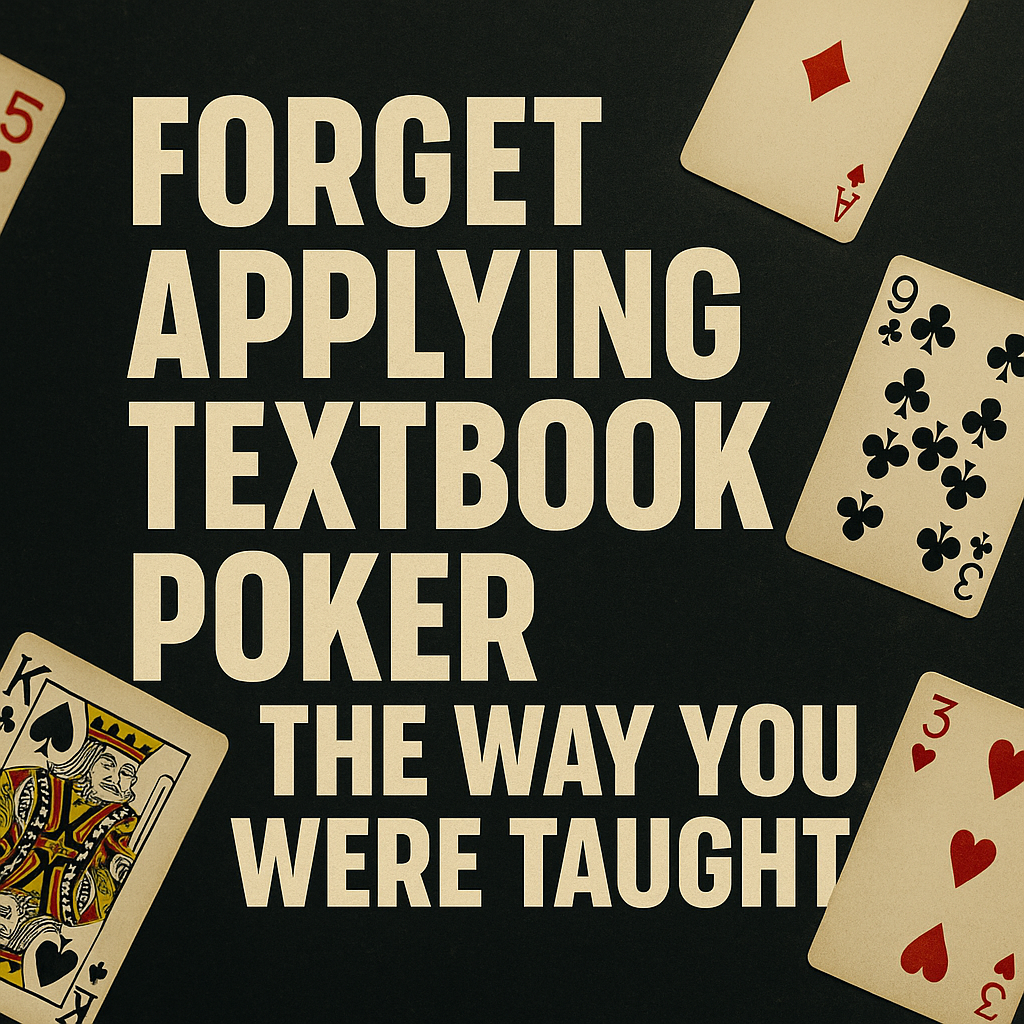
Let me give you an example.
I was holding pocket Kings, in a $1/$3 no-cap buy-in game — a premium hand by any textbook standard. I raised to $25. Six callers. SIX.
The flop comes 8-5-2 rainbow. I make a solid continuation bet. Three calls. Turn is a blank. Bet again. Two calls. River brings a 6… and some clown turns over 7/4 offsuit for a straight.
Welcome to modern live poker.
Forget fold equity — it doesn’t exist. Forget hand probabilities — no one even knows what they are and forget ranges — they’re playing everything. GTO? You might as well be solving calculus at a demolition derby.
This isn’t poker as we knew it. This is chaos in a cage match. And if you want to survive — if you want to even have a chance to beat bad poker players — you need a new strategy. A new mindset. And a new way to navigate this lawless jungle of suited trash and drunken aggression.
THE TOOLS OF REAL POKER VS THE RISE OF FEEL-FIRST CHAOS
Poker, at its core, is a game of structured decision-making. Great players know this. They build every move — from preflop to river — on a foundation of proven tools:
✅ Pot odds
✅ Hand probabilities
✅ Fold equity
✅ Positional advantage
✅ Range construction
✅ Table dynamics
These aren’t gimmicks or fads. They’re the pillars of strategic poker. They’re why the same players consistently win, even across different games and locations.
But when you walk into most low-stakes live games today, especially in full-ring formats, you’re not up against people who use these tools. In fact, you’re not even playing the same game.
You’re surrounded by players — mostly younger and middle-aged — who don’t study, don’t read, and don’t reflect. Their poker education comes from watching highlights of Poker After Dark or some edited-down YouTube mashup where the loudest guy at the table always wins. These shows are poker entertainment, not poker education — but that distinction is lost on most of the room.
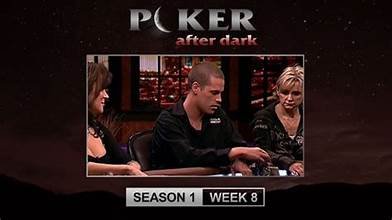
THIS IS BIGGER THAN POKER
And this is bigger than poker. It’s cultural.
We now live in a time where facts are optional and feelings are the preferred compass. Strategy is seen as “overthinking.” Math is “too complicated.” The modern player doesn’t want to learn; they want to vibe their way to victory. They’ve adopted a kind of performative alpha-aggression — raise first, think later — believing confidence will carry the day. If they lose, they blame luck. If they win, they’re a genius.
And this leaves you — the disciplined player — in a brutal spot. You’re armed with tools that actually work… but only if your opponents are playing the same game. What happens when they aren’t? When math is ignored, position is meaningless, and logic is met with chaos?
Before we dive into how to fight back, we first need to ask why this style of play has taken over so many low-stakes games. What’s really behind it? Is it just ignorance — or something deeper in the way people think today? And how do you beat it?
Let’s take a closer look.
SIDEBAR: WHY DO THEY PLAY THIS WAY?
If you’re trying to beat bad poker players, you first need to understand why they consistently ignore strategy, logic, and math. They aren’t just uninformed—they’re trapped in predictable patterns rooted in modern psychology.
ILLUSORY SUPERIORITY (THE DUNNING-KRUGER EFFECT)
RISK-TAKING & SENSATION SEEKING
THEATER POKER LEARNING (TV TAUGHT ME THAT)
Many players believe they’re better than they are — a cognitive bias that leads them to trust “gut reads” over math. They overestimate their skill while lacking even basic knowledge of odds, position, or ranges.
Low-stakes games often attract dopamine junkies. They play trash hands, chase gutshots, and fire wildly — not because it’s smart, but because it’s exciting. Action feels like progress.
They didn’t study. They watched TV. Shows like Poker After Dark and YouTube highlights taught them that aggression wins, drama is strategy, and folding is weakness. They learned performance, not poker.
EMOTION OVER ANALYSIS
THE EDUCATION DEFICIT
Welcome to the “vibe generation.” Strategy is seen as overthinking. “I had a hunch” trumps pot odds. Discipline is boring. Logic is ignored. Emotion runs the show.
Math and critical thinking are in steep decline. Most players don’t understand pot odds, equity, or expected value — because they were never taught. This isn’t laziness. It’s a systemic failure that follows them to the felt.
Before we dive into how to counter this madness, it’s worth remembering that none of this is an accident. The reckless play you see at the table — the blind aggression, the total disregard for odds and position — stems from a cocktail of overconfidence, emotional decision-making, and a fundamental lack of education in math and strategy. These players aren’t breaking the rules of poker because they’re rebels. They’re breaking them because they don’t even know the rules exist.
And that brings us to the problem with traditional poker strategy — it assumes your opponents do.
WHAT TRADITIONAL STRATEGY SAYS-AND WHY IT FAILS HERE
Traditional poker strategy is built on structure — a disciplined framework of starting hand requirements, positional awareness, pot odds, hand probabilities, and fold equity. These tools are not just helpful; they are essential in most competitive poker environments.
But in live low-stakes games full of undisciplined players, that structure collapses.
You’re not playing against opponents who understand the principles you’re using. You’re playing against players who haven’t studied, haven’t read a single poker book, and wouldn’t know pot odds from a pothole. They’re not adjusting ranges based on position, stack depth, or table image. They’re clicking buttons in real life — not out of ignorance, but out of sheer disinterest in strategy.
What happens next? You make a perfectly timed value bet — and get called by bottom pair. Or you apply a pressure move — and they snap-call with a gutshot. You raise preflop with pocket Kings — and get cracked by 7/4 off-suit who “just had a feeling.”
.
HERE'S THE KICKER: THESE ARE EXACTLY THE KINDS OF PLAYERS YOU WANT AT YOUR TABLE-JUST NOT 7 OF THEM
One or two? Great. You can trap them, isolate them, and extract value.
But when seven or eight players at the table are calling every raise with junk, the math starts working against you.
There are only 13 card ranks in the deck. In a full 9-handed game, 18 cards are dealt preflop. If you’re going 5–7 ways to every flop, that means most of the deck’s card ranks are already in play. The odds that one of your opponents connects with their garbage hand actually increases — especially when they’re chasing any two suited, any connectors, any face cards, or ace-anything.
Even when you start ahead, you’re often drawing dead without realizing it — not because you played poorly, but because the chaos of the table turns correct decisions into coin flips or worse.
This is why standard poker theory — as valid and foundational as it is — doesn’t hold up in these environments.
It’s not that the math is wrong.
It’s that no one else is using it.
And that’s the paradox: to beat bad poker players, you have to understand that they’re not just breaking the rules — they’re playing a different game altogether.
THE NEW REALITY-HOW TO THINK DIFFERENTLY
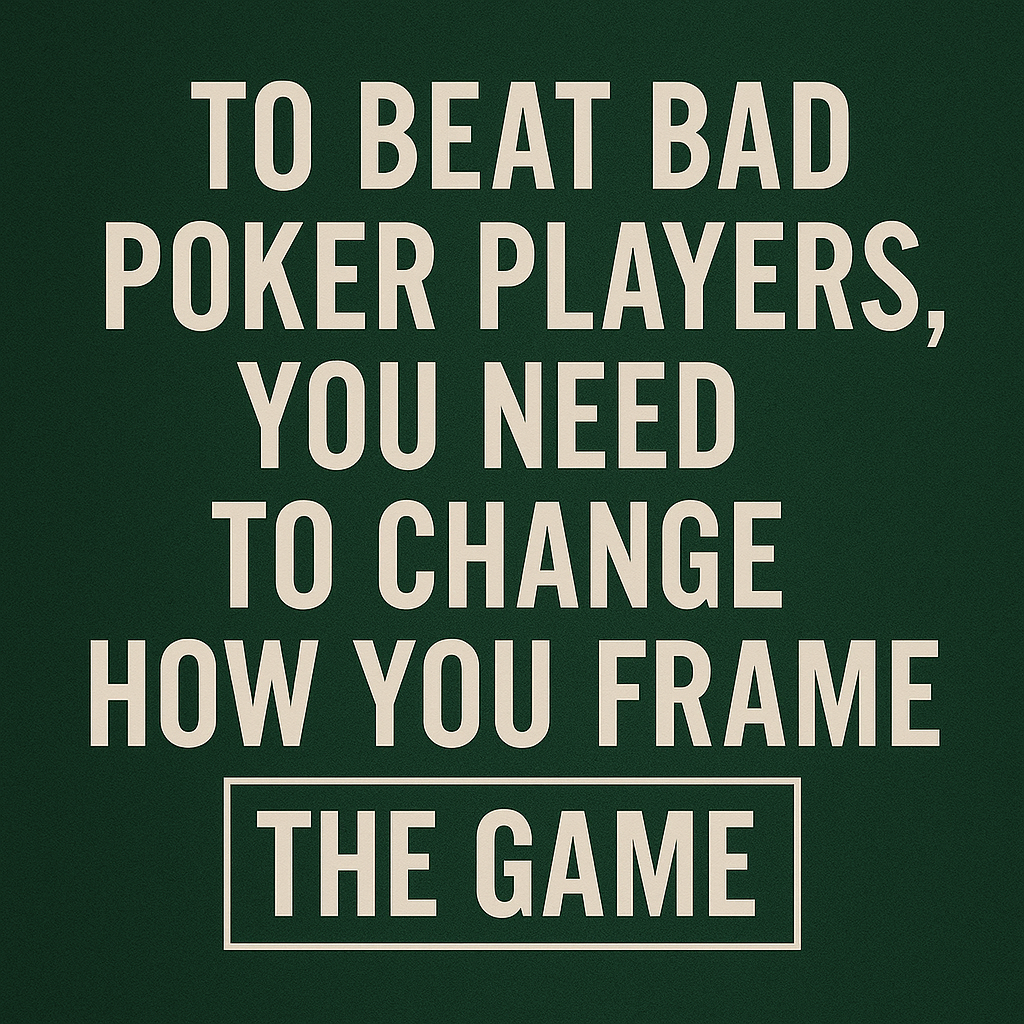
So what now?
You’re sitting at a table where half the players are calling with 7-4 offsuit, raising with Queen-Four suited, and stacking off with bottom pair and a dream. You’ve reviewed the hand odds, studied pot odds, practiced GTO lines, and trained your discipline — and now you’re getting run down by a guy who thinks “fold equity” is a poker room in Tulsa.
It’s time to adjust.
To beat bad poker players, you need to change how you frame the game.
You don’t abandon math — you adapt it to reality.
You don’t stop using strategy — you modify your execution.
Here’s the shift:
In these games, your job is no longer to outwit your opponents — it’s to outlast their chaos.
That means:
TIGHTEN YOUR RANGE
INCREASE YOUR DISCIPLINE
THINK IN TERMS OF ROBUSTNESS
START LOOK FOR DURABILITY
Tighten your range, especially preflop. Only play hands that can stand up to five or six-way action.
Increase your discipline, not your aggression. The default aggression at these tables is already maxed out.
.
Think in terms of robustness, not trickery. Deception doesn’t matter when your opponents aren’t paying attention.
Start looking for durability, not balance. GTO is irrelevant when no one is exploiting your frequencies — because no one is even observing them.
NO BLUFFING & NO TRUSTING TELLS
Tells can be powerful in skilled games. A hesitation might reveal weakness. A chip grab might scream confidence. But for tells to be useful, the player has to have at least some degree of competence — a foundational understanding of hand value, betting logic, and position.
A lot of bad players don’t.
You might see rock-solid posture and unwavering eye contact — not because they’re trapping with a monster, but because they’re confidently holding pocket eights on a K♠ Q♦ 10♣ board. And they’re proud of it. They don’t know they’re crushed. They just know, “I’ve got a pair. That’s good, right?”
So while body language may tell you how they feel about their hand, it tells you nothing about how strong that hand actually is.
In these games, tells aren’t reliable. They’re performance art.
.
And bluffing? Forget it. Trying to bluff players who don’t fold is a direct flight to burnout. If you’re still relying on fold equity at these stakes, you’re playing the wrong game. These players will call you down with, bottom pair, or no pair at all, just Ace High. Then they’ll tell you they “knew you had it,” just before they muck and rebuy.
These players are not reading your betting patterns, calculating equity, or assessing board texture. They’re firing bets because they “felt good about the flop.”
But playing solid, tight, positionally aware poker with an understanding of how wide their ranges are? That gives you a huge edge.
To beat bad poker players, you must embrace the idea that good poker isn’t about being clever — it’s about being correct, consistently, even when surrounded by inconsistency.
PRACTICAL ADJUSTMENTS FOR SURVIVAL & PROFIT
You’ve now seen why traditional strategy falters in these environments — but that doesn’t mean these games are unbeatable. In fact, this is exactly the type of player you want at your table. Just not seven of them.
If you find yourself surrounded by loose, wild, math-ignoring, feel-based players, you’ll need more than strong fundamentals — you’ll need practical survival tactics.
TABLE SELECTION IS EVERYTHING
BRING A PATIENCE BANKROLL
EMOTION IS THE ENEMY
If you have two or three of these players at your table, you’re in heaven.
But if it’s the entire table, it becomes statistically difficult to win. In a 9-handed game, 18 cards are dealt preflop — that’s 1.38 cards per rank. Go five to seven ways to the flop, and the odds of someone connecting are simply higher than yours, no matter how tight you play. That’s just math. And you can’t beat math long-term.
🔍 Translation: It’s not the player type that’s the problem. It’s the concentration of them.
If there are too many, get up. Change tables.
Variance in these games is massive. You can play perfectly and still lose. Just ask anyone who’s watched their overpair get cracked by 7/4 offsuit.
If your bankroll — or ego — can’t handle wild swings, you’ll burn out fast.
Playing these games successfully means understanding that profit comes not from consistency, but from capitalize-and-sit-back moments. You may win 3 big pots a night and fold dozens of hands in between.
Tilt is a killer in these games. When your flopped set loses to runner-runner flush or someone snap-calls your pot-sized bet with Queen/Three and hits the three for two pair — you’ll be tempted to “punish” them.
Don’t.
They’re not thinking, and they’re not adjusting. They’re not trying to exploit you.
All they’re doing is just… playing.
If you can’t detach emotionally from absurd plays, you’ll lose your edge, and soon your bankroll with it.
🧩 These are the keys to actually beat bad poker players — or at least survive long enough to profit. This isn’t about elegant theory. It’s about staying sharp in chaos, recognizing when a game has gone from juicy to dangerous, and making smart, disciplined decisions in the middle of madness.
NOT EVERY TABLE IS WORTH PLAYING
Here’s a harsh truth you won’t find in most poker books:
Not every table is worth playing.
Sometimes it’s because the players are too good — a lineup full of disciplined TAGs where everyone folds preflop, plays tight ranges, and never stacks off light.
Other times, it’s because the players are too bad — calling stations, thrill-seekers, bingo players chasing gutshots with no fold button in sight.
DIFFERENT PROBLEMS. SAME RESULT.
A few weeks ago, I sat down at a table where I knew every player — all TAGs. I laughed as I took my seat and said,
“I won’t be here long — we’re all just going to sit here, and no one is going to win a dime.”
Sure enough, I had a table change within minutes.
Now flip the script:
You’re at a table with seven players who call every raise.
They see every flop.
They chase every draw — no matter the odds, no matter the price.
Sounds like a dream, right?
But here’s the kicker: it’s not.
When six or seven players see the flop, the math flips on you.
In a 9-handed game, 18 cards are dealt. That’s nearly 1.5 cards per rank.
The chances that someone hits something on each street skyrocket.
You’re no longer betting against one range. You’re betting against a crowd.
Even when you’re ahead, you won’t hold up often enough to matter.
Just like that TAG table, there’s no long-term edge here either.
Too tight, you don’t get paid.
Too loose, you don’t get through.
Either way — you don’t win.
So here’s the rule:
If you wouldn’t play against a table full of TAGs…
Why are you trying to beat a table full of maniacs?
The answer is the same: don’t play, get a table change.
If you can’t find a table where mistakes are made in isolation, not by everyone at once — then find a different table. If there’s no better table, go take a break.
Don’t sink into the chaos and tell yourself you’re just “running bad.”
You’re not running bad.
You’re sitting in the wrong game.
LET THE BAD PLAYERS REMAIN BAD
Whatever you do, never give this type of player advice. We don’t want to fix them — we love them exactly the way they are. The fact that they all landed at one table is unusual, but it happens. Sometimes one or two otherwise solid players join the herd mentality and start splashing around too. Doesn’t matter.
Because tomorrow night — or two hours from now — they’ll be scattered across the room again, right where we want them: isolated and exploitable.
I have a friend — let’s call him Ted (not his real name) — who just can’t help himself. He explains pot odds and equity to these folks mid-hand. I tell him the same thing every time: stop trying to educate your opponents.
We don’t want to change them. We want to charge them — one bad decision at a time.

